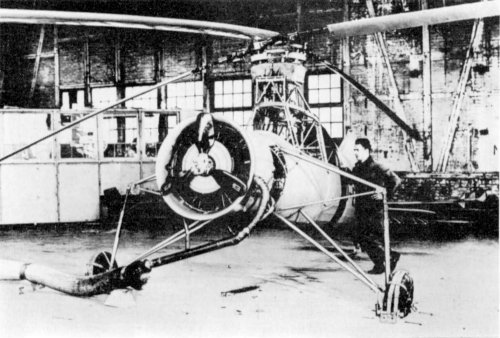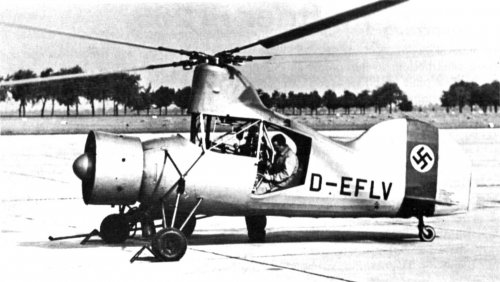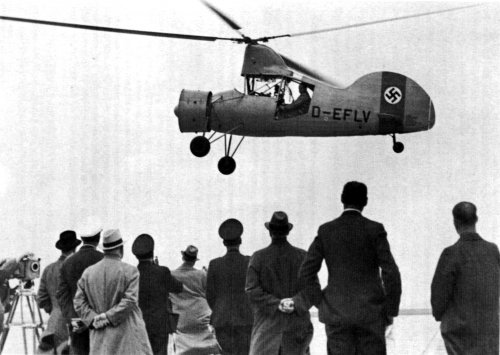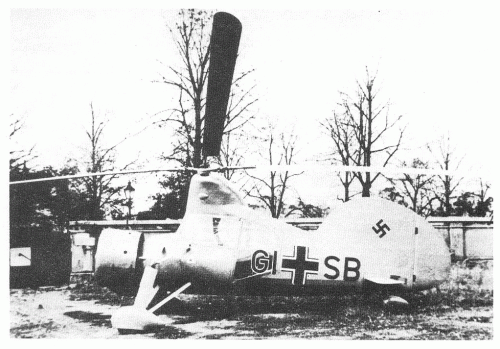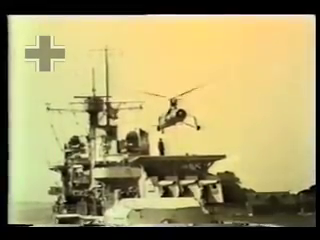- Joined
- 25 June 2009
- Messages
- 14,753
- Reaction score
- 6,153
The first helicopter with intermeshing rotors was built by Anton Flettner and his team at Berlin's Johannistal airfield in 1938. It was flown by test pilot was former Arado chief test pilot, Flugkapitän (Captain) Richard Perla.
The Fl 265 was commissioned by the RLM and built in deep secrecy with the assistance of the supervising engineers Lucht and Reidenbach. The airframe of a Fw 44 Stieglitz was used as a basis, requiring the crankshaft of the 140 hp Siemens-Halske engine to be extended to the rear, so that the main drive shaft of the rotors could be driven by a bevel gear. The two rotors, each 6.50 m in length were made from seamless drawn steel tube.
The control was carried out by a hanging stick that had to be operated by the pilot. Rod ends transferred the control stick movements to the rotors. Torque was completely abolished and consequently there was no need for a tail rotor.
The test aircraft, designated Fl 265 V1, carried the registration D-EFLV ("E" for weight under 1000 kgs, "FL" for Flettner and "V" for Versuchsflugzeug or research aircraft). It flew in the hands of Captain Perla in a heavily guarded hall in the vicinity of Johannistal airfield. In order to learn this new "flying experience", the helicopter was tethered to the ground during these test flights. In the course of the tests the length of the wires was restricted to 2 meters, until finally the first unfettered flight was made in the open air after 3 months with 5-meter wires.
Designer Anton Flettner promised his test pilot a reward of RM 1,000 if he could maintain the machine still in the air at 10 m for 5 minutes. During the flight tests the aircraft reached altitudes of 1200 m and a horizontal speed of 128 km/h. The plane was then successfully demonstrated in Rechlin before Hitler, Goering, milk, Reidenbach and Lucht.
A second prototype designated Fl 265 V2 was built. Both aircraft were used to detect submarines of warships. Due to its good flying qualities, A. Flettner received a contract to further develop the Fl 265. Its successor was the famous Fl 282 Kolibri.
Adapted from: Luftfahrt International No.5, Sept.-Oct. 1974
The Fl 265 was commissioned by the RLM and built in deep secrecy with the assistance of the supervising engineers Lucht and Reidenbach. The airframe of a Fw 44 Stieglitz was used as a basis, requiring the crankshaft of the 140 hp Siemens-Halske engine to be extended to the rear, so that the main drive shaft of the rotors could be driven by a bevel gear. The two rotors, each 6.50 m in length were made from seamless drawn steel tube.
The control was carried out by a hanging stick that had to be operated by the pilot. Rod ends transferred the control stick movements to the rotors. Torque was completely abolished and consequently there was no need for a tail rotor.
The test aircraft, designated Fl 265 V1, carried the registration D-EFLV ("E" for weight under 1000 kgs, "FL" for Flettner and "V" for Versuchsflugzeug or research aircraft). It flew in the hands of Captain Perla in a heavily guarded hall in the vicinity of Johannistal airfield. In order to learn this new "flying experience", the helicopter was tethered to the ground during these test flights. In the course of the tests the length of the wires was restricted to 2 meters, until finally the first unfettered flight was made in the open air after 3 months with 5-meter wires.
Designer Anton Flettner promised his test pilot a reward of RM 1,000 if he could maintain the machine still in the air at 10 m for 5 minutes. During the flight tests the aircraft reached altitudes of 1200 m and a horizontal speed of 128 km/h. The plane was then successfully demonstrated in Rechlin before Hitler, Goering, milk, Reidenbach and Lucht.
A second prototype designated Fl 265 V2 was built. Both aircraft were used to detect submarines of warships. Due to its good flying qualities, A. Flettner received a contract to further develop the Fl 265. Its successor was the famous Fl 282 Kolibri.
Adapted from: Luftfahrt International No.5, Sept.-Oct. 1974

